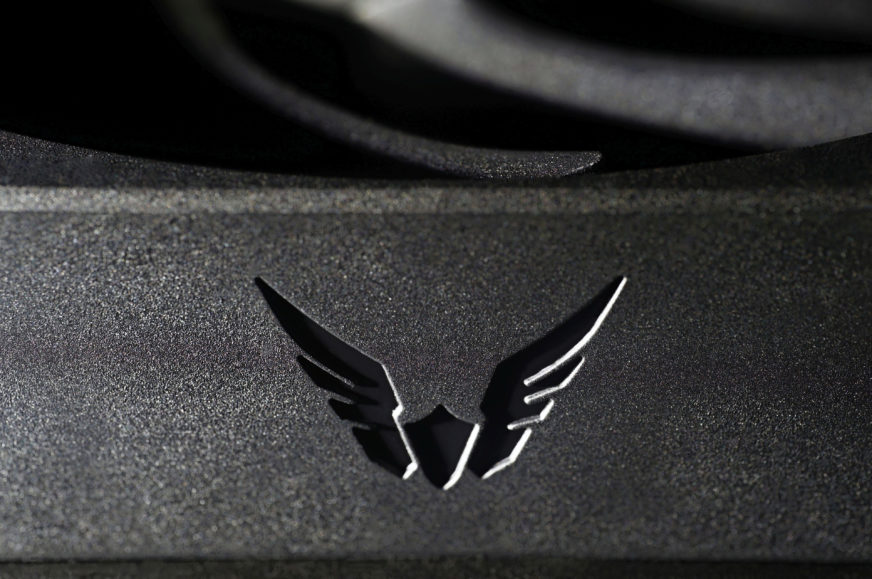Evaluation
You might be saying that you know the rotor of this fan and that Valkyrie was inspired by the Gentle Typhoon D1225C a little too much. But that’s okay. Mainly the positives were taken from said template and the biggest negative – high vibrations – was avoided. And although some things could still be worked on, in the context of ARGB LED models the X12 fan fares quite well.
Evaluation
The basic characteristic is reminiscent of the situation around the SeaSonic MagFlow 1225 PWM – the aerodynamically very efficient rotor suffers from weaker acoustic qualities of the motor and perhaps partly of the bearings as well (although their involvement is likely to be relatively small given the fluid type). It should be noted, however, that this is nothing terrible and the Valkyrie X12’s operation is quieter than SeaSonic’s in this regard. Rather, these are multiple thin peaks in the 850–-1650 Hz band, which could be likened to whistling. There is no whirring (such as that which accompanies the Cooler Master SickleFlow 120 ARGB) to speak of.
For many, the sound of the motor may not be annoying, but we have to mention it. Otherwise, it wouldn’t be entirely clear why the Valkyrie fan X12 falls behind aerodynamically quite significantly to the Noctua NF-12×25 PWM, which is a fan with a similar rotor. Of course, there are more reasons, but one of the main ones is the higher motor noise. At comparable speeds (regardless of noise) the Valkyrie X12 achieves very similar airflow. However, if the test modes are aligned by equal noise levels, then naturally the overall quieter fans are at an advantage. Not just aerodynamically, but motor-wise.
The X12’s aerodynamic sound is relatively quiet in an unobstructed environment, perhaps surprisingly so. After all, we expected a PBT rotor with this geometry to vibrate more. Thus, even at high speed (around 2000 rpm) the vibrations on the blades are at the level of the NF-A12x25. Sure, the vibrations that get on the frame are a bit higher. However, one must also take into account the exceptionally hard corners of the Valkyrie fan, which don’t damp the vibrations too much. It’s not worth talking about anyway – vibrations are negligible – but this fact does bring one new insight.
With sufficient thickness, an extremely strong polymer does not need to be used for this type of rotor. That is, at least unless they are downright high-speed fans, where a stronger material with lower thermal expansion will become more and more important as speed increases. However, if we stay in the normal speed classes (500~2200 rpm), the X12 example shows well that even thicker PBT is sufficient, as the blades do not vibrate and thus do not generate tonal peaks. Of course, this statement applies to 9-blade rotors, which don’t stretch the blades to extremes. For fans with fewer, longer blades, such as the Arctic P12/P120, this is no longer the case – those won’t easily avoid significant vibration withthout a properly stiff material or hoops.
Despite the very low vibration of the Valkyrie X12, some tonal peaks with obstacles do arise. However, this is from airflow. The fan is noisier at higher speeds (from 1400 rpm) on a grille and even on radiators. Below 1200rpm, however, the X12 is already quite pleasantly quiet and performs well on radiators by the standards of lighted models. At lower speeds, the motor noise also fades away. On radiators, the Valkyrie X12 is the most efficient (i.e. with the best airflow-to-noise ratio) 120-millimeter ARGB fan we’ve tested to date. Thanks to high static pressure, it also thrives on other types of obstacles, although it already has some competition there, often in the form of cheaper fans. If there’s one place where the X12 can justify the higher price, it’s on radiators.
If you’re choosing between the ARGB LED fans and you’re intrigued by the Valkyrie X12, you’ll still want to think about whether you’ll mind the lower luminosity of the LEDs. Or rather “spot” (in the corners) lighting is quite pronounced, but on the surface of smaller light guides that will not fully illuminate your case even at maximum brightness. In short, it’s different than fans that conduct light through the entire rotor. Naturally, the luminance to power draw ratio is also below average. But the airflow per unit of power draw is already decent. And certainly the high performance of the motor is also excellent, with a large margin for adverse conditions (whether due to a highly restrictive environment or the natural increase in friction through use). It’s just a pity that the motor doesn’t switch off at lower PWM duty cycle and the starting/minimum speeds are quite high (about 770 rpm).
Overall, we rate the Valkyrie X12 fan positively. There will always be some technical issues, but the important thing is that this or that fan is really good at something within its category. And the X12 with its high efficiency stands out nicely among ARGB models in applications that put more resistance on the fan.
English translation and edit by Jozef Dudáš
| Valkyrie X12 |
| + Suitable for every use case |
| + Cooling efficiency (airflow/pressure per unit of noise) at a very high level |
| + High airflow and static pressure even through an obstacle... |
| + ... top-notch among ARGB fans |
| + Wide speed range |
| + Really powerful motor |
| + Extremely low, negligible vibrations (even at maximum speed) |
| + Robust design |
| + Extra support for hubs with 6-pin connectors |
| + ARGB LED lighting |
| - Annoying motor at higher speeds... |
| - ... and also operation with some types of obstacles |
| - Higher minimum speeds (approx. 770 rpm)... |
| - ... without passive mode support at low PWM duty cycle |
| - Eventual collision with nylon dust filter |
| Approximate retail price: 28 EUR |
- Contents
- Valkyrie X12 in detail
- Overview of manufacturer specifications
- Basis of the methodology, the wind tunnel
- Mounting and vibration measurement
- Initial warm-up and speed recording
- Base 6 equal noise levels…
- ... and sound color (frequency characteristic)
- Static pressure measurement…
- … and airflow
- Everything changes with obstacles
- How we measure power draw and motor power
- Measuring the intensity (and power draw) of lighting
- Results: Speed
- Results: Airlow w/o obstacles
- Results: Airflow through a nylon filter
- Results: Airflow through a plastic filter
- Results: Airflow through a hexagonal grille
- Results: Airflow through a thinner radiator
- Results: Airflow through a thicker radiator
- Results: Static pressure w/o obstacles
- Results: Static pressure through a nylon filter
- Results: Static pressure through a plastic filter
- Results: Static pressure through a hexagonal grille
- Results: Static pressure through a thinner radiator
- Results: Static pressure through a thicker radiator
- Results: Static pressure, efficiency by orientation
- Reality vs. specifications
- Results: Frequency response of sound w/o obstacles
- Results: Frequency response of sound with a dust filter
- Results: Frequency response of sound with a hexagonal grille
- Results: Frequency response of sound with a radiator
- Results: Vibration, in total (3D vector length)
- Results: Vibration, X-axis
- Results: Vibration, Y-axis
- Results: Vibration, Z-axis
- Results: Power draw (and motor power)
- Results: Cooling performance per watt, airflow
- Results: Cooling performance per watt, static pressure
- Airflow per euro
- Static pressure per euro
- Results: Lighting – LED luminance and power draw
- Results: LED to motor power draw ratio
- Evaluation












